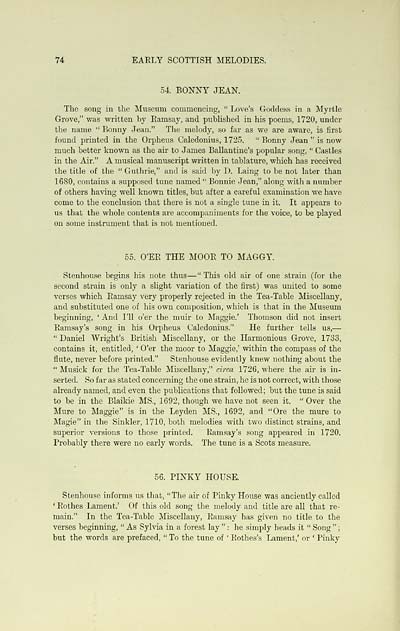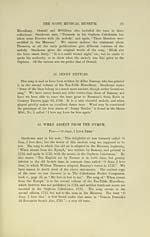Glen Collection of printed music > Printed text > Early Scottish melodies
(96) Page 74 - Bonny Jean
Download files
Complete book:
Individual page:
Thumbnail gallery: Grid view | List view

Y4 EAELY SCOTTISH MELODIES.
54 BONNY JEAN.
The song in the Museum commencing, " Love's Goddess in a Myrtle
Grove," was written by Eamsay, and published in his poems, 1720, under
the name " Bonny Jean." The melody, so far as we are aware, is first
found printed in the Orpheus Caledonius, 1725. " Bonny Jean " is now
much better known as the air to James Ballantine's popular song, " Castles
in the Air." A musical manuscript written in tablature, which has received
the title of the " Guthrie," and is said by D. Laing to be not later than
1680, contains a supposed tune named " Bonnie Jean," along with a number
of others having well known titles, but after a careful examination we have
come to the conclusion that there is not a single tune in it. It appears to
us that the whole contents are accompaniments for the voice, to be played
on some instrument that is not mentioned.
55. O'ER THE MOOR TO MAGGY.
Stenhouse begins his note thus — " This old air of one strain (for the
second strain is only a slight variation of the first) was united to some
verses which Ramsay very properly rejected in the Tea-Table Miscellany,
and substituted one of his own composition, which is that in the Museum
beginning, ' And I'll o'er the muir to Maggie.' Thomson did not insert
Ramsay's song in his Orpheus Caledonius." He further tells us, —
" Daniel Wright's British Miscellany, or the Harmonious Grove, 1733,
contains it, entitled, ' O'er the moor to Maggie,' within the compass of the
flute, never before printed." Stenhouse evidently knew nothing about the
" Musick for the Tea-Table Miscellany," circa 1726, where the air is in-
serted. So far as stated concerning the one strain, he is not correct, with those
already named, and even the publications that followed ; but the tune is said
to be in the Blaikie MS., 1692, though we have not seen it. " Over the
Mure to Maggie" is in the Leyden MS., 1692, and "Ore the mure to
Magie" in the Sinkler, 1710, both melodies with two distinct strains, and
superior versions to those printed. Ramsay's song appeared in 1720.
Probably there were no early words. The tune is a Scots measure.
56. PINKY HOUSE.
Stenhouse informs us that, "The air of Pinky House was anciently called
' Eothes Lament.' Of this old song the melody and title are all that re-
main." In the Tea-Table Miscellany, Ramsay has given no title to the
verses beginning, " As Sylvia in a forest lay " : he simply heads it " Song " ;
but the words are prefaced, " To the tune of ' Rothes's Lament,' or ' Pinky
54 BONNY JEAN.
The song in the Museum commencing, " Love's Goddess in a Myrtle
Grove," was written by Eamsay, and published in his poems, 1720, under
the name " Bonny Jean." The melody, so far as we are aware, is first
found printed in the Orpheus Caledonius, 1725. " Bonny Jean " is now
much better known as the air to James Ballantine's popular song, " Castles
in the Air." A musical manuscript written in tablature, which has received
the title of the " Guthrie," and is said by D. Laing to be not later than
1680, contains a supposed tune named " Bonnie Jean," along with a number
of others having well known titles, but after a careful examination we have
come to the conclusion that there is not a single tune in it. It appears to
us that the whole contents are accompaniments for the voice, to be played
on some instrument that is not mentioned.
55. O'ER THE MOOR TO MAGGY.
Stenhouse begins his note thus — " This old air of one strain (for the
second strain is only a slight variation of the first) was united to some
verses which Ramsay very properly rejected in the Tea-Table Miscellany,
and substituted one of his own composition, which is that in the Museum
beginning, ' And I'll o'er the muir to Maggie.' Thomson did not insert
Ramsay's song in his Orpheus Caledonius." He further tells us, —
" Daniel Wright's British Miscellany, or the Harmonious Grove, 1733,
contains it, entitled, ' O'er the moor to Maggie,' within the compass of the
flute, never before printed." Stenhouse evidently knew nothing about the
" Musick for the Tea-Table Miscellany," circa 1726, where the air is in-
serted. So far as stated concerning the one strain, he is not correct, with those
already named, and even the publications that followed ; but the tune is said
to be in the Blaikie MS., 1692, though we have not seen it. " Over the
Mure to Maggie" is in the Leyden MS., 1692, and "Ore the mure to
Magie" in the Sinkler, 1710, both melodies with two distinct strains, and
superior versions to those printed. Ramsay's song appeared in 1720.
Probably there were no early words. The tune is a Scots measure.
56. PINKY HOUSE.
Stenhouse informs us that, "The air of Pinky House was anciently called
' Eothes Lament.' Of this old song the melody and title are all that re-
main." In the Tea-Table Miscellany, Ramsay has given no title to the
verses beginning, " As Sylvia in a forest lay " : he simply heads it " Song " ;
but the words are prefaced, " To the tune of ' Rothes's Lament,' or ' Pinky
Set display mode to: Large image | Transcription
Images and transcriptions on this page, including medium image downloads, may be used under the Creative Commons Attribution 4.0 International Licence unless otherwise stated. ![]()
| Special collections of printed music > Glen Collection of printed music > Printed text > Early Scottish melodies > (96) Page 74 - Bonny Jean |
|---|
| Permanent URL | https://digital.nls.uk/91348726 |
|---|---|
| Description | Also: O'er the moor to Maggy. Also: Pinky house |
| Description | Scottish songs and music of the 18th and early 19th centuries, including music for the Highland bagpipe. These are selected items from the collection of John Glen (1833 to 1904). Also includes a few manuscripts, some treatises, and other books on the subject. |
|---|
| Description | The Glen Collection and the Inglis Collection represent mainly 18th and 19th century Scottish music, including Scottish songs. The collections of Berlioz and Verdi collected by bibliographer Cecil Hopkinson contain contemporary and later editions of the works of the two composers Berlioz and Verdi. |
|---|

